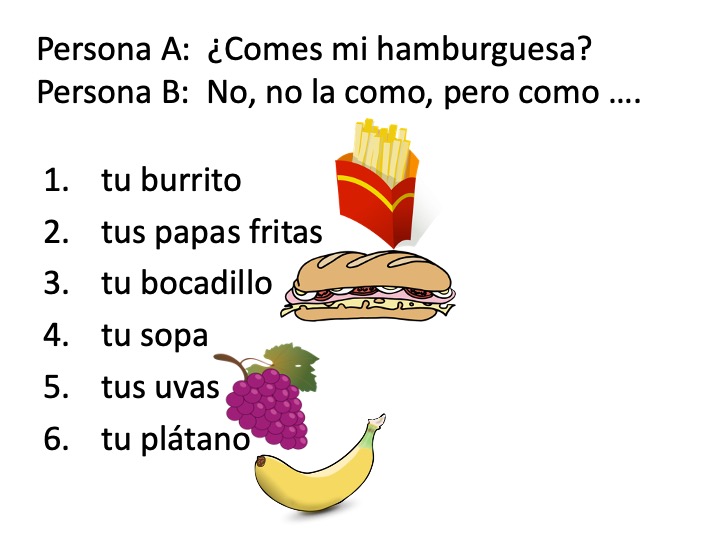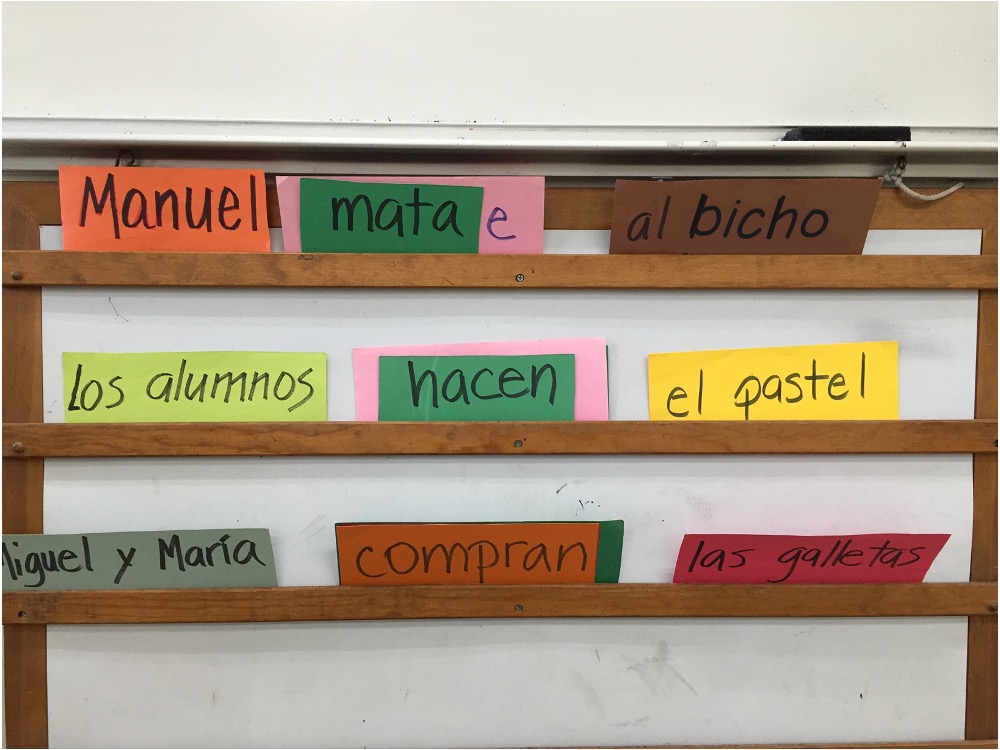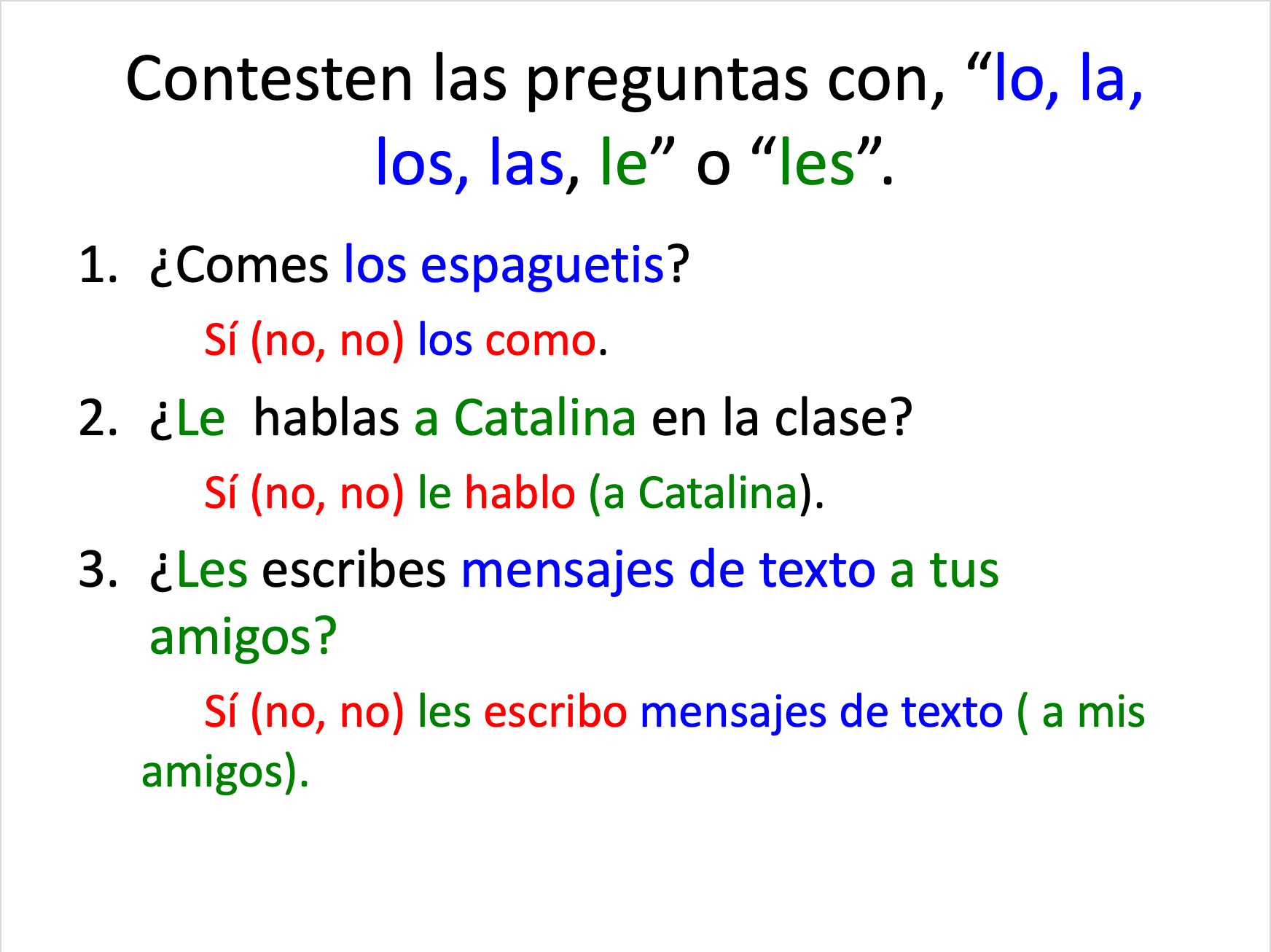Easy Trick for Indirect and Direct Objects Spanish
Then, I show the beginning of a video demonstrating the use in context of the direct object pronouns.
- I assign a super-fun Google Drive Activity that allows students to move parts of speech around and answer more questions.
- Students play the dice game to practice speaking. Since the choices of answers are already written correctly, they are speaking correctly without effort, like riding a bike with training wheels.

3. SPANISH OBJECT PRONOUNS VS. SUBJECT PRONOUNS: Teach the difference between subject and object pronouns
I begin the next lesson with more comprehensible input. Then, using a slot board*, I ask students which pronouns they would use for certain nouns. For example, in the sentence, "Mi madre come el pastel," which pronoun would you use for, "Mi madre"? I guide them to the correct answer, and replace "Mi madre," with "Ella," on the slotted board. Then, I ask them which pronoun they would use for "el pastel." When they answer, I show them the sentence, "Él come lo," and see if they correct me. If they don't, I show them the correct order. I explain how to use the direct object pronoun LO to replace a masculine noun and LA to replace a feminine noun.
I continue in this fashion a few more times during the "explain" portion of the lesson.
Then, I do a check-for-understanding activity and a practice activity using the PowerPoint.

TEACHING DIFFERENT TYPES OF PRONOUNS
Then, using the slot board again, I show them how to use direct object pronouns with two verbs. "Lo quiere comer. / Quiere comerlo." The pronoun comes before the conjugated verb or at the end of the second verb, the infinitive form. I don't explain the term, "transitive verb," or the "leísmo" used in parts of Spain; I explain that in Spanish Four and AP. I try to keep it as simple as possible.
I make sure to have a VIP (Visual Instructional Plan from Fred Jones Tools for Teaching) on the board: Sujeto pronombre, objeto pronombre, verbo: Tú la tienes.

Competition: I divide the class into two teams. Students answer questions using direct object pronouns writing on the white boards.
4. SPANISH INDIRECT OBJECT PRONOUNS LE AND LES, STEP THREE: Teach English Grammar
WHAT!!!???
Yes! Before I teach the indirect object pronouns in Spanish, I teach students a bit of English grammar. After banging my head against the wall many times while teaching los complementos, I realized students were not grasping the concept in Spanish because they didn't know the difference between the subject pronoun and the object pronoun or the direct object pronoun and the indirect object pronoun in English. For that reason, I suspended my 100% target language instruction for a week and taught the English pronouns, subject AND object.
Since the sentence order of the pronouns is different in Spanish and English, students MUST be able to identify subject, object, and indirect object pronouns in order to use them correctly.
Using a slotted board, I explain the parts of speech. "Paul and Mary" are the subject, the doer of the action. The verb is, "kills." Kills what / whom? Kills the bug. That's how you find the direct object, by asking, "VERB WHAT?" or "VERB WHOM?".
Then, we practice a few more times and I ask, "What is the subject of the sentence? The verb? The direct object?"
Then I say,
To find the indirect object, first find the direct object. WE BUY THE FLOWER FOR BILL. Buy what? Buy the flower. Direct. For whom? For Bill. We'll talk about Bill later.
How do you find the direct object? By asking, 'VERB WHOM?' Or, 'VERB WHAT?'.
I ask students to help me replace the nouns with pronouns. What is the pronoun for Paul and Mary? For bug?
Then I ask them if it's OK to use the subject and object pronouns interchangeably. (It kill they.) Of course, the answer is no. I tell them that bad grammar, in English, is still understood. "Me and Anne have to take a test." However, in Spanish if you get the pronoun wrong, you will not be understood.
I also show them how, in English, the indirect object comes before the direct object: Paul gave ME the ball. In Spanish, the indirect object pronoun comes before the verb. Raúl ME echa la pelota.
In the English sentence, "Paul gave the ball to me," ME is the object of the preposition "to" and NOT an indirect object pronoun. "To me," is a prepositional phrase. In Spanish, "me" is the indirect object pronoun because it is the indirect receiver of the action, and there is a preposition involved: "to me; for me."
In the previous sentence, "We buy the flower for Bill," Bill is the object of the preposition, "for." In a Spanish sentence, "Bill," would be the indirect object.
I say,
In order to get past the verb, you must step over the hurdle of the preposition. Therefore, it is INDIRECT. You can't get directly to it; the preposition is in the way.
Check for understanding: Students have cards with parts of speech written on them: verb, subject, subject pronoun, direct object, direct object pronoun, indirect object, indirect object pronoun.
I put sentences up on the slot board and point to words and students lift their cards to show me which part of speech it is.
Students work in pairs to identify the parts of speech. Here is the Parts of Speech Worksheet and PowerPoint Answers.
5. SPANISH INDIRECT OBJECT PRONOUNS LE AND LES
Using the slot board, then the PowerPoint, I demonstrate how "le" and "les" are necessary when there is an indirect object pronoun in a Spanish sentence, and it is a third person. For example, "Le mando una carta a Felipe." (Some native speakers may argue this rule, but it is correct usage.)
Students participate in a competition in which they answer questions on white boards using a direct or indirect pronoun.

MORE CI
I tell a story with tons of object pronouns. Students answer true/false questions, then fill in the cloze story with the correct pronouns. I also have an autocorrecting Google Forms version.
6. TEACH, "ME TE NOS."
Using the PowerPoint, I teach me, te, nos and show how they can be both direct or indirect.
Then, I use puppets to narrate a funny dialogue so students can hear the pronouns in context.
Then, students complete interactive notebook activities and a Flipbook.
Students compete in a competition in which they answer questions using, "me, te," or "nos." We either play Tic Tac Toe or Throw the Ball.
Students are now ready to produce, so they do a paired activity, answering questions using, "me, te," or "nos."
More comprehensible input: Students listen to the song, "Te odio," and do a Cloze activity.
7. TEACH DOUBLE-OBJECT PRONOUNS IN SPANISH: Le changes to se
Using first, the slotted board, then the PowerPoint, I show students how to use double-object pronouns, replacing the pronoun le or les with "se." The PowerPoint animation quickly converts, "Le doy el libro," to "Se lo doy," and shows how LE LO becomes SE LO, visually making the concept understandable.
This is tricky because it takes a while for it to sink in that, even when there is an indirect object in the sentence, "le" is still used. For example, "Le doy el osito a Pablo." Both of the following sentences are correct, "Se lo doy," and, "Se lo doy a Pablo." However, you may hear the "se" omitted at times in regular Spanish conversations.
More Comprehensible Input
I throw the teddy bear around and say, "Le doy el osito a Pepe. Pepe se lo da a Ana. Ana se lo echa a María," etc.
I show the PowerPoint, "El osito," narrating the story about the boy who steals the teacher's teddy bear. Students answer comprehension questions orally.
I show the video, "Object Pronouns" again, so students can hear the single and double-object pronouns in context.
Learning is always easier when it's fun, so now I add a competition, girls against boys. Students answer questions using direct, indirect, and double-object pronouns.
Lastly, students participate in another speaking paired activity for more speaking practice.
This is a condensed version of my Spanish Lessons for the Direct and Indirect Object Pronouns. Many more details are included in my curriculum. If you would rather not write your own lesson plans, why not use mine? There are seventeen 90-minute lesson plans with all of the activities mentioned above and much more. I teach all the special rules for Spanish pronouns, the order of parts of speech (which pronouns go in front of the verb, and which at the end of the infinitive verbs), parts of speech, and how "les las" becomes "se las" in double-object pronouns. The curriculum includes a dice game, interactive notebook activities, a PowerPoint, paired activities, bell work, an autocorrecting Google Forms activity, daily homework, audio files, a culture project, a song, classroom instructional and motivational strategies, Cloze activities, quizzes, tests, and more.
*The wooden slot board was made for me by a friend. You can make one of your own or buy an inexpensive one at an education store. You could even try a magnetic board.
Don't miss out on freebies! Make sure to follow my STORE in order to get notified of updates on products, free resources, and new products. Happy teaching!
If you would like to receive these blog posts with teaching tips and freebies in your email, subscribe to my monthly newsletter: Best PowerPoints and More for Spanish and French Just scroll down to the bottom and click, "Sign up."
Connect with me on social media!
YouTube
throsbynowerelf99.blogspot.com
Source: https://bestpowerpointsforspanishclass.com/indirect-and-direct-object-pronouns-spanish-the-best-way-to-teach-them/
0 Response to "Easy Trick for Indirect and Direct Objects Spanish"
Post a Comment